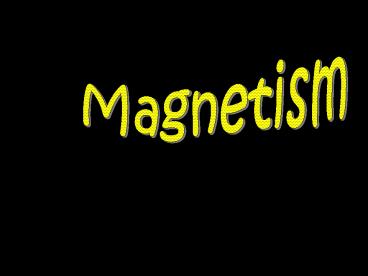Magnetism - PowerPoint PPT Presentation
Title: Magnetism
1
Magnetism
2
(No Transcript)
3
(No Transcript)
4
(No Transcript)
5
Magnetic field Region where a magnetic
influence (force) can be felt. Lines are drawn
to represent the strength and direction of the
field. Field is represented from N to S.
6
Magnetic Forces
- Magnetic forces, like electrical forces, are
forces that act at a distance. (Objects do not
have to be in contact.) - Like poles repel each other opposite poles
attract.
7
Magnetic Poles
- Northseeking poles- point northward.
- South-seeking poles point southward.
- Important difference between electric charges and
magnetic poles is that electric charges can be
isolated, but magnetic poles cannot.
8
Domain Theory
- All magnetism is due to the motion of electrons.
- Electrons spin, like the earth, setting up
magnetic poles. (paramagnetism) - Electrons revolve around the nucleus, like the
earth around the sun. (diamagnetism) - Electrons are paired in orbitals. Paired
electrons spin opposite directions- creating
opposite magnets. The magnetic poles therefore
cancel each other. Unpaired electrons create
stronger magnets. (ferromagnetism)
9
- Magnetic domains- clusters of aligned atoms
Magnetic Saturation all the domains are
aligned Dropping a magnet can cause the domains
to become unaligned.
10
(No Transcript)
11
(No Transcript)
12
Select your answer a or b and explain why.
13
DO NOT COPY the questions. Answer each with an
illustration (drawing.)1. What is the
advantage of using a horseshoe magnet over a bar
magnet assuming the two are identical as bar
magnets?2. You are required to build a model
of the Earth and its magnetic field using a ball
of clay and a bar magnet. You will be forming
the clay Earth around the magnet. What is the
orientation (direction) of the magnet?
14
- Concept check 1
- Must every magnet have a north and south pole?
Explain. - How can a magnet attract a piece of iron that is
not magnetized? - Why will a magnet not pick up a penny or a piece
of wood? - If you break a magnet have you destroyed it?
15
(No Transcript)
16
- An iron nail is strongly attracted to the north
end, the south end or both ends of a magnet
equally strong. - Magnetism is due to the motion of the electron as
they __________ and ______________. - Several nails dangle from the north pole of a
magnet. The induced pole on the top of the first
nail is______. The induced pole on the bottom of
the lowestmost nail is _______.
17
- A moving electron has a ___________ field and an
___________field around it. - Magnetic field lines show the ________ and the
__________ of the field. - A magnetic field goes from _____ to ____.
- Paramagnetism is due to _________.
Diamagnetism is due to ____________. - Ferromagnetism is due to _____________.
18
Magnetism and Current
- What causes all magnetism?
- What is current?
- Will current cause magnetism?
19
(No Transcript)
20
(No Transcript)
21
(No Transcript)
22
Electromagnets
Materials list
wire
power supply (current)
core (anything from air to metal)
- The strength of an electromagnet can be increased
by - increasing the current in the wire,
- increasing the number of turns of wire, or
- by using a metal core.
23
Faradays Law
The induced voltage in a coil is proportional to
the number of loops multiplied by the rate at
which the magnetic field changes within those
loops.
24
Lenzs Law
The current induced in a wire is such as to
oppose the force that induced it.
25
(No Transcript)
26
Generator
Mechanical energy electrical energy
Motor
Electrical energy Mechanical
energy
27
Domain Theory Paramagnetism- weak attraction
due to spin of electrons Diamagnetism weak
repulsion- due to revolving electrons Ferromagnet
ism strong-due to unpaired electrons
Magnetism vs. electricity Both due to
electrons Both force at a distance Both like
repel unlike attract BUT magnetic poles cannot
be separated
Magnetism

